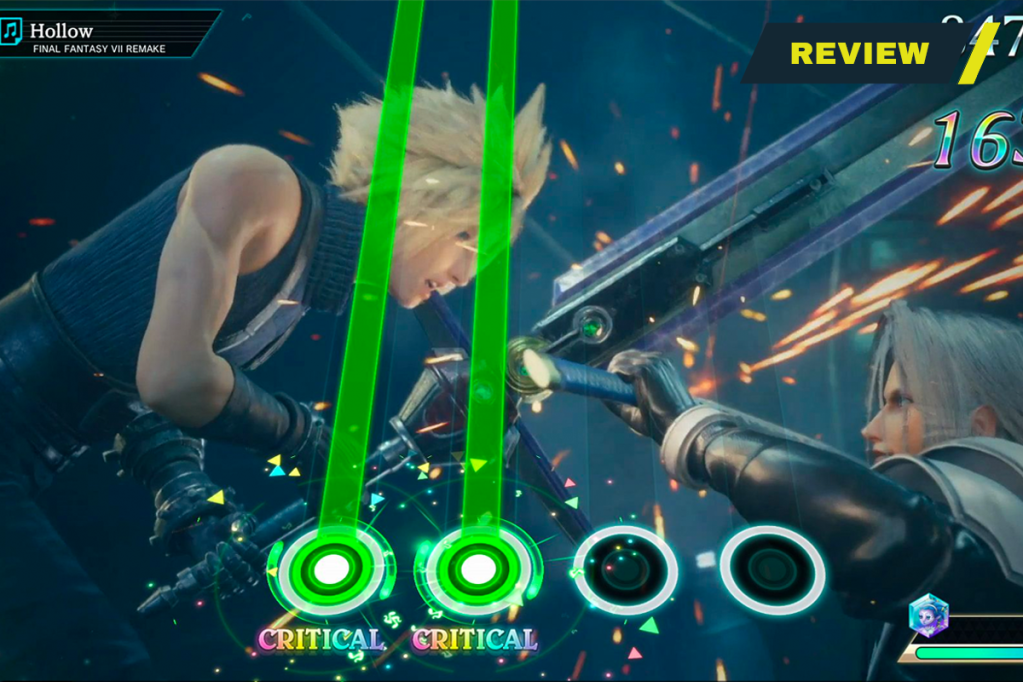After wowing 3DS owners and arcade players, Square Enix’s Theatrhythm series makes its way onto home consoles for the first time with its largest entry yet. Despite not having Final Fantasy in its name, likely due to the plans to add music from other Square Enix role-playing games like NieR and Chrono Trigger, it’s still the focus of the base game and is filled with great fan service. While it loses a bit of its tactile gameplay by moving away from touchscreens, Theatrhythm Final Bar Line is an incredibly well-crafted rhythm game with some of the best music in gaming history.
Any concerns about how Final Bar Line would play in this new form quickly disappear as the series’ rhythm stays on beat while making the transition to consoles. Rather than tapping the screen or swiping, players either press buttons to register taps or use analog sticks to swipe. This change in control method takes a bit to get used to, especially if you’re awkwardly moving your thumbs back and forth between the buttons and analog stick. However, once I changed my positioning on the controller to using the bumper buttons to “tap” and then had my thumbs free to be on the analog sticks at all times, I quickly found my groove.
The main mode is called Series Quests and features 29 Final Fantasy series to go through ranging from all the main entries to the more obscure stuff, like Chocobo’s Dungeon and Mystic Quest. Most series you unlock add playable characters that you can add to your party, which can be leveled up and learn skills that assist you during songs (such as healing spells that’ll keep you from failing so quickly). While it’s still ultimately a music game that requires accurate inputs to succeed, it has a unique RPG layer that ties into its many side missions, giving it a lot of replay value beyond the basic chase for high scores.
Like past games, there are three types of stages in Final Bar Line. The most basic is Battle Music Sequence that features beats coming down multiple tracks and has you keeping up with the rhythm while your on-screen party battles enemies and bosses. Things get a bit more complex in Field Music Sequence levels, which have a singular lane but add lengthy paths where players have to move up or down to stay in rhythm.
This was previously done by moving the stylus up or down and is now done by holding the analog stick up or down. It’s not quite as slick as the touchscreen movement, given the tactile feedback of touchscreens, but it works well. Finally, the Event Music Sequence stages feature pre-rendered videos and vertical highways similar to Rock Band. Although they all look and function slightly differently, the actual gameplay stays largely the same across all three types of levels due to the use of controller inputs. It’s consistent, yet still presented in different enough ways.
Songs in the Series Quests mode are often accompanied by some stipulations, such as damage being doubled or beats coming faster than normal. This helps make iconic boss theme songs feel all the more challenging and a big deal, although there are multiple difficulty levels to ensure players never get stuck. Unlocked songs are then made available to play in the game’s two other modes, Music Stages, which is essentially free play and where you’ll spend your time chasing high scores, and its frantic Multi Battle mode.
Rather than just having players go up against one another for a high score, Multi Battle feels more like Tetris Battle. Up to four players can go up against one another and doing well will trigger battle items that impact the other players. These range from fat Chocobos that block the screen to smaller icons to the super devious fake notes that can throw off a player’s entire run. Of course, these wilder options can be turned off, so if you want a more serious competition, you can do so, but the more outrageous and unpredictable action is better since it made the mode unique. Did I do terribly each time I got fake notes coming down the lane? Of course. I lost by thousands of points, but I also had a blast even in defeat.

With three distinct and worthwhile modes, Theatrhythm Final Bar Line will keep players busy for quite a while. Unlocking all of its 385 songs will take many hours and fine-tuning your party to finish the missions in Series Quests will take even longer. There are also many collectibles to unlock, such as trading cards that can give your characters small boosts, and 100 optional feats to test your skills at achieving. The strength of its core systems ensures that these aren’t symptoms of bloat and are instead thoughtful ways to keep players engaged.
With great mechanics and even better music from the Final Fantasy series, the party never has to stop in Theatrhythm Final Bar Line. There’s no shortage of goals to achieve, whether it’s just unlocking the songs or getting S ranks on all tunes, and it’s all supported by its musical gameplay that is always rewarding after the short acclimation period. Square Enix has crafted a spectacular experience here, one that is a fantastic rhythm game that also happens to celebrate many of the company’s most beloved RPGs.
SCORE: 9/10
As ComingSoon’s review policy explains, a score of 9 equates to “Excellent.” Entertainment that reaches this level is at the top of its type. The gold standard that every creator aims to reach.
Disclosure: The publisher provided a PlayStation 4 copy for our Theatrhythm Final Bar Line review. Reviewed on version 1.00.










